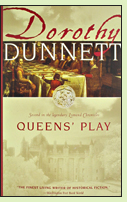Queens' Play
by Dorothy Dunnett
Reviewed by Margaret Tomlinson

Second in the Lymond Chronicles series, Queens' Play finds its fascinating hero, Francis Crawford of Lymond, visiting France. Mary of Guise, the Queen Dowager of Scotland, wants him to devote his considerable talents to protecting her seven-year-old daughter, Mary Queen of Scots, from assassination. Lymond agrees to go to France as a free agent, in disguise, and to "tell her as much or as little as he chose of the world of plots, of secrets and of intriguing he had undertaken to enter."
Dunnett makes a similar sort of compact with the reader. Not all is as it seems in this novel; readers are likely to find themselves astonished at regular intervals when the author suddenly whisks away concealing veils to reveal that she and Lymond have cleverly misled them. This is a trickster of a novel with a serious and complex core of history and psychology just beneath the surface fun. That said, the plot is somewhat easier to follow - where the author wants it to be - than the plot of The Game of Kings, the first novel in the series.
The fiction in Queens' Play is blended with historical fact. Mary Queen of Scots was indeed raised in the French court from the age of five and did not return to Scotland until she was a nineteen-year-old widow. The Scottish Queen Dowager did indeed, during her travels with the French court in 1550, learn of a plot to poison her daughter. Tensions had eased between Scotland, England and France as the governing bodies in those countries came to accept that young Mary would wed the heir to France. Would Mary's death have shattered the fragile equilibrium? And if so, who stood to benefit? If the novel introduces a variety of entirely fictional escapades surrounding its kernel of history, most readers will find them too entertaining and too well integrated with the history to quarrel with. (1964, 432 pages) More about Queen's Play at Powell's Books or Amazon.comOther novels set in sixteenth-century Scotland or France:
The Game of Kings by Dorothy Dunnett (1961); #1 in the Lymond Chronicles series. See review or more info at Powell's Books
The Memoirs of Mary Queen of Scots by Carolly Erickson (2009), the story of Mary, Queen of Scots, told in the form of a memoir. More info
The Confessions of Catherine de Medici by C.W. Gortner (2010), a sympathetic portrayal of the infamous sixteenth-century French queen. See review or more info at Powell's Books
Nonfiction about the French court during the childhood of Mary Queen of Scots:
Mary Queen of Scots by Antonia Fraser (1969). More info
Catherine de Medici by Leonie Frieda (2005), about the wife of Henri II and the mother of the future husband of Mary Queen of Scots. More info
Henri II, His Court and Times by H. Noel Williams (1910), about the French king and future father-in-law of Mary Queen of Scots. More info
Online:
Mary of Guise, a Wikipedia article about the mother of Mary Queen of Scots, who in Queen's Play asks Lymond to come to France to look after Mary
Back to Novels of the Renaissance
Back to Directory of Book Reviews